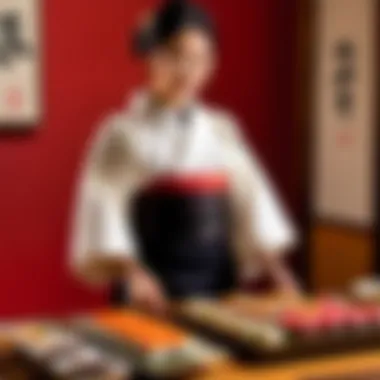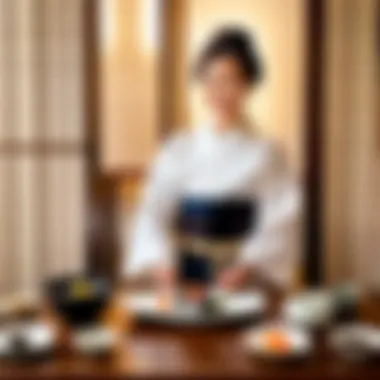Maru Maki: A Cultural Cuisine Journey


Intro
Maru maki, a distinct sushi form, is a reflection of Japan's culinary aesthetics and cultural narratives. At first glance, one might think of sushi as simply a combination of rice and fish. But maru maki stretches beyond these fundamentals. This article aims to illuminate the multifaceted layers that compose maru maki, taking readers on a journey through its rich history, meticulous preparation, and status in contemporary cuisine.
Understanding maru maki involves recognizing its origins rooted deep in Japan's storied past. Each roll tells a tale, often containing meanings that reflect seasons, festivals, and regional specialties. Moreover, maru maki’s preparation is an art form, a dance of technique and tradition, where chefs share their skills passed down through generations. As we explore this topic, we will also consider its adaptations and influences that have emerged in global cuisine, providing a 360-degree view of maru maki's relevance today.
In diving into these aspects, both the seasoned sushi lover and the curious newcomer can appreciate the depth of this culinary gem. Through the detailed examination that follows, the objective becomes clear: to explore maru maki not just as food, but as a cultural phenomenon that resonates well beyond its plate.
Preface to Maru Maki
Maru maki is not just another type of sushi; it represents a confluence of culinary artistry and cultural richness that is both profound and significant. Understanding maru maki is vital within the framework of Japanese cuisine, as it encapsulates centuries of tradition intertwined with modern innovation. As we guide through this exploration, it’s crucial to appreciate how maru maki reflects societal values, communal bonds, and the aesthetic sensibilities of Japanese culture.
An essential point to consider about maru maki is its visual appeal and symbolic meaning. Unlike other sushi forms, its circular shape signifies unity and wholeness. This aspect becomes particularly notable during celebrations and gatherings, where food serves not just to satiate hunger but also to strengthen ties amongst people. Additionally, the article will address the markedly meticulous manner in which each roll is crafted, showcasing the delicate balance between flavor and presentation that makes maru maki distinct.
Notably, maru maki extends beyond the mere act of eating. It encompasses a wide range of ingredients, each chosen with care, presenting a language of taste that speaks to both the past and future of culinary practices in Japan. The importance of recognizing sourcing practices, sustainability, and respect for nature will surface prominently during our journey. This awareness contributes to the broader conversation about the ethical consumption, something increasingly relevant in today's global discourse.
In short, the introduction of maru maki encapsulates a gateway into understanding Japanese culture through its food. It serves as a compelling prelude, laying the foundation for our deeper dive into its definition, its historical backdrop, and its ongoing evolution in the culinary world.
Defining Maru Maki
Maru maki is characterized by its circular rolling of rice and fillings, showcasing how the act of preparation is reminiscent of an art form. The word "maki" means rolled, while "maru" translates to round, emphasizing its signature shape. Each slice reveals vibrant colors from fresh ingredients, inviting the viewer while promising an explosion of flavors. Maru maki is distinguished not merely by taste but also by its aesthetic, adhering to the Japanese principle of wabi-sabi, which finds beauty in imperfection.
Historical Context
Origins of Sushi
The genesis of sushi can be traced back to the practice of preserving fish in fermented rice. The rice cultivated during this time acted as a medium for fermentation, ensuring the fish could be stored longer. Eating the rice itself was not common; rather, it was discarded, showing a deep respect for the resourcefulness of ingredients available. This conservation technique laid the groundwork for sushi as we know it today.
The introduction of vinegar to rice began transforming the sushi landscape, making it more palatable and appealing. This particular aspect opened the doors to various regional adaptations, as diverse as the people enjoying the flavors—each formulation led down paths that would eventually birth maru maki's unique identity.
Evolution of Maru Maki
As sushi culture spread beyond Japan, regional adaptations began to emerge, illustrating the flexibility inherent in maru maki. Travel to the United States exemplifies this transformation, where the California Roll was born, utilizing avocado and crab, ingredients not traditionally associated with Japanese sushi. This fusion reflects the adaptability of maru maki and how it can transcend cultural borders.
The evolution also highlights a growing trend towards inclusivity within the culinary sphere. People are now experimenting with different fillings and sauces, integrating local flavors which not only make maru maki more accessible but also enrich its narrative. However, this adaptability might sometimes tread on the delicate line of cultural appropriation, raising ongoing discussions regarding authenticity in modern cuisine.
In essence, exploring maru maki leads us to a rich tapestry of history, adaptation, and artistry—all of which play a pivotal role in understanding its cultural significance today.
"Food is a necessity, but the experience it creates is what nourishes the soul."
From its birth as a method of preservation to its present-day evolution, maru maki embodies a reflection of societal values, showcasing a culinary journey that is still continuing as chefs and home cooks innovate daily.
The Art of Making Maru Maki
Maru Maki is not just a dish; it's a fine representation of Japan's culinary finesse. The art of creating Maru Maki encompasses an array of techniques and ingredients, each playing a crucial role in the overall experience. Whether someone is enjoying this type of sushi in a cozy restaurant or trying to replicate it at home, understanding the foundational elements involved can make a substantial difference in quality and presentation of the final product. Not only is it about creating something delicious but also about weaving culture and tradition into every bite.
Essential Ingredients


Types of Rice
Choosing the right rice is pivotal when it comes to Maru Maki. Sushi rice or "shari" is generally used, which is a short-grain rice known for its sticky texture. This stickiness is essential as it binds the ingredients together, preventing them from escaping when the sushi is rolled. One of the notable characteristics of sushi rice is its ability to absorb flavors. Seasoning it with a delicately balanced mixture of rice vinegar, sugar, and salt enhances its taste, lending an additional layer of flavor to the final product.
A major advantage of using proper sushi rice is its perfect texture – neither too firm nor too mushy. However, one disadvantage could be the amount of care required in the cooking process; getting the right water-to-rice ratio can be tricky. Still, opting for high-quality Japanese rice such as Koshihikari brings authenticity to the dish, making it a popular choice.
Choosing Fresh Fish and Vegetables
Selecting fresh fish and vegetables is another cornerstone of crafting superb Maru Maki. Freshness impacts the overall flavor and safety of the sushi. Indeed, handling and sourcing these ingredients carefully ensures that microbial risks are minimized while enhancing taste. A hallmark of choosing fresh is understanding seasonal availability; for instance, tuna is best in winter while mackerel is more prevalent during summer months.
The key characteristic here is the idea of "Omakase" where the chef handpicks the freshest ingredients for a dish. Being mindful of where the ingredients come from is a substantial trend today. Local seafood markets, for example, could provide a direct connection to the source, which enhances the dining experience by emphasizing sustainability.
Yet, sourcing local ingredients might come with limitations in terms of variety compared to more global selections. However, knowing your suppliers can add a unique charm to your culinary journey, making it more personal.
Preparation Techniques
Perfecting the Rice
Perfecting the rice is crucial in sushi-making. Rinsing the rice multiple times until the water runs clear will remove excess starch, which otherwise might affect its texture. Once cooked, the proper method of seasoning with vinegar, sugar, and salt must be followed to achieve that distinctive taste of sushi rice. A unique feature of this process is the cooling technique; after combining the seasoning and the rice, it must be fanned to achieve a glossy finish.
Notably, this technique not only enhances aesthetics but also helps in keeping the rice at an ideal temperature, which complements the overall meal experience. A challenge can be making sure not to over-season or under-season, which can often lead to a less satisfying flavor.
Rolling Techniques
Rolling techniques are vital for shaping your Maru Maki correctly. While it might look effortless to an observer, the maneuver is intricate and requires practice. Utilizing a bamboo mat, the rice should be spread evenly before placing the ingredients in the center. Gentle pressure is key; too firm can result in squished fillings, while too light can leave the sushi loose.
One attractive aspect of rolling is the variety of styles you can experiment with. Using different rolling techniques gives rise to distinct presentations and flavors. The method taught most commonly is the "inside-out" roll, where the rice is on the outside, giving a different visual appeal. However, the downside is that this may make the sushi more challenging to handle and requires precision.
Presentation and Serving
Plating Options
When it comes to plating, Maru Maki is as much a visual experience as it is a gastronomical one. The presentation often involves a beautiful arrangement that draws inspiration from Japanese aesthetics. Using a simple slate board or a bamboo platter can set the stage effectively to emphasize the colors and textures of the sushi.
One beneficial aspect is the addition of garnishes like pickled ginger or wasabi that not only serve as condiments but also enhance the overall look. A meticulous arrangement can elevate the dining experience, turning a simple meal into a celebration of craftsmanship.
However, the challenge is to maintain simplicity without overcrowding the plate, which can detract from the hero of the dish itself; if one gets too fussy with the designs, it can overshadow the culinary art.
Pairing with Condiments
Pairing Maru Maki with condiments is an extension of its flavors and an essential part of the dining experience. Soy sauce is a classic accompaniment, providing a salty contrast that enhances the umami of the fish. Alongside soy sauce, there’s also the option of adding wasabi, which can add a kick of heat and spice.
A key advantage of pairing correctly is the ability to personalize your experience. For example, some people prefer a touch of lemon juice for a zesty twist, which could beautifully complement the fish. Different condiments allow each diner to adjust the flavors according to their individual palates. However, the disadvantage is that one must be careful not to overpower the delicate nuances of Maru Maki with heavy sauces, as they might mask its natural flavors.
"The journey of Maru Maki is not solely about the ingredients, but about the process, the culture, and the art behind it. Each roll tells a story, connecting the past with the present, the domestic with the global."
Through mastering the art of making Maru Maki, individuals not only hone their skills but also engage deeply with Japanese culture, enhancing their appreciation and understanding of this unique culinary form.


Cultural Significance of Maru Maki
Maru Maki, often simply recognized as a sushi variant, transcends mere culinary delight—it serves as an emblem of tradition, community, and ethical considerations within contemporary society. This part of the article uncovers the multifaceted role Maru Maki plays in Japanese culture and its ethical implications, including sustainability practices that have garnered increasing global awareness. Through its aesthetic appeal and rich heritage, Maru Maki stands as a testament to the artistry of food while navigating the waters of modern ethical discourse.
Maru Maki in Japanese Culture
Social Gatherings
Social gatherings in Japan are instances where food becomes an anchor for connection. Maru Maki presents itself as an excellent choice for these occasions, being both shareable and visually appealing. It is common to see families come together, whether during intimate dinners or larger get-togethers like weddings.
A key characteristic of such gatherings is that they encourage interaction; guests often engage in the joyful act of rolling or preparing their own sushi. This participatory dining experience enriches communal bonds and fosters an atmosphere of togetherness. By serving Maru Maki, hosts convey warmth and hospitality. Additionally, the beauty of the presentation adds a layer of elegance to any table setting, making it a popular choice in both casual and formal cultures.
However, preparation must be thoughtful. Use of fresh, high-quality ingredients can sometimes be cumbersome. It requires planning and some skill in sushi making. Yet, the reward is a delectable meal that packs flavor and fosters connections.
Festivals and Celebrations
Festivals in Japan serve as vibrant spectacles of tradition, heritage, and culture. Maru Maki often plays a notable role in these celebrations, such as New Year festivities or various seasonal events. Here, cultural symbols can be seen wrapped within the sushi, as certain ingredients provide not just flavor but also meaning, denoting luck or prosperity.
The unique feature of incorporating Maru Maki into such events highlights the respect for tradition while also adapting to modern tastes. It is both a satisfying dish and a canvas for creative expression, allowing for an array of fillings that cater to diverse palates.
As delightful as it is, the preparation for events can also be time-consuming. The need to cater to large groups when hosting a celebration can become an uphill task. Nevertheless, many families still consider it worthwhile, as the joy Maru Maki brings far overshadows any hassle in the kitchen.
Sustainability and Ethical Practices
Impact on Marine Life
Sustainability emerges as a pressing concern in today’s culinary landscape, and Maru Maki is at the center of this dialogue. The impact on marine life—specifically relating to overfishing and habitat destruction—demands attention. Awareness about the origins of ingredients is critical; thus, responsible sourcing has become paramount.
Promoting sustainable practices in Maru Maki preparation not only preserves biodiversity but also enriches the overall dining experience. By utilizing fish and seafood from ethical sources, chefs and home cooks alike contribute positively to marine conservation. Education about these practices can elevate the dish beyond food—consider it a conscious choice for diners who care deeply about environmental well-being.
However, diving into sustainable sourcing can sometimes restrict the availability of certain seafood. This could lead to alterations in traditional recipes. Still, the push for sustainability remains a beneficial endeavor, offering a chance to innovate and adapt.
Local Sourcing
Local sourcing represents another significant facet of Maru Maki preparation. By utilizing locally-grown ingredients, whether vegetables or fish, culinary artisans not only cut down on carbon footprints but also support local economies. This practice aligns well with today’s consumer preference for fresh produce and authentic experiences.
A defining characteristic of local sourcing is its ability to connect the hearts and minds of diners with their communities. It emphasizes the importance of seasonality and prompts innovation in recipes, allowing chefs to create unique variations that reflect regional flavors and cultural contexts.
However, the challenge lies in consistency. Dedicating oneself to local sourcing requires commitment and sometimes limits choices during off-seasons. Yet, this long-term vision contributes to a more robust and diverse culinary landscape, ensuring that Maru Maki remains a focal point in the conversation surrounding food, culture, and sustainability.
The cultural significance of Maru Maki stretches far beyond taste; it encompasses social bonds, celebrations, and an ethical future we can all support.
Maru Maki Variations Around the World
The culinary landscape is always shifting, blending age-old techniques with modern twists. Maru Maki, while deeply rooted in Japanese cuisine, has not escaped this evolution. Understanding its variations across different cultures emphasizes its adaptability and popularity on a global scale. This becomes critical as it reflects not only the dish's journey beyond Japan but also the intermingling of flavors and traditions that enhance the dining experience.
Fusion Cuisine


Ingredient Adaptations
When we talk about ingredient adaptations in the context of fusion cuisine, we’re diving into how traditional Maru Maki ingredients get a makeover. Think about classic white rice being swapped for quinoa or brown rice; or fresh tuna taking a backseat for grilled chicken or even vegan alternatives like marinated tofu. This adaptability makes Maru Maki a canvas upon which chefs can paint with familiar and often local colors. The key characteristic here is that ingredients can be modified to cater to various dietary preferences—vegetarian, gluten-free, or low-carb. This not only widens the dish’s appeal but also ensures it stays relevant in a fast-evolving culinary world.
One unique feature of these adaptations is the experimentation with flavor profiles. Ingredients like sriracha, spicy mayonnaise, or even sweet fruit like mango could easily transform the flavor landscape of traditional Maru Maki. The advantage is vast; people get to enjoy sushi even if they may not have previously been interested in raw fish or other typical offerings. A potential downside? Some purists may argue that such changes can strip the dish of its authentic essence.
Regional Influences
Regional influences in Maru Maki variations exhibit just how much different cultures can shape traditional dishes. Every region offers a different take; for example, in Mexico, you might find spicy sauces and cilantro incorporated, while in Italy, there's potential for the addition of pesto or prosciutto. What stands out here is how local culinary traditions can lend their flair to Maru Maki, making it resonate more with local taste buds.
The benefit of embracing these regional variations lies in their ability to create a unique identity for Maru Maki in diverse culinary settings. As diners become more adventurous, incorporating local ingredients may very well enhance the overall experience. Yet, some might point out that these regional adaptations could dilute the pure Japanese spirit the dish embodies.
Popular Global Versions
California Roll
One of the most recognized adaptations of Maru Maki globally is the California Roll. This roll creatively rewrites the traditional sushi script by flipping the usual filling and using avocado and imitation crab for an approachable introduction to sushi. The California Roll is popular not just for its ingredients but for its alluring presentation. Visually, it translates well on platforms like Instagram, making it a favorite among the social media savvy.
This unique feature has made it a staple in non-Japanese sushi restaurants and a go-to for newcomers to sushi cuisine. Its accessibility is a significant advantage—people usually feel more at ease trying something that doesn’t look overtly traditional. However, skeptics argue that it doesn’t represent true sushi, thus sometimes leading to debates among sushi connoisseurs.
Sushi Burritos
Sushi burritos are another exciting global variation. Here, the traditional roll takes on the shape and concept of a burrito, with ingredients artistically bundled in seaweed and rice. This creation appeals to the on-the-go crowd. A defining characteristic of sushi burritos is their size; they’re substantial enough to serve as a meal, which satisfies those looking for a heartier option.
The sushi burrito's advantage lies in its versatility; diners can customize their rolls with an array of ingredients, making it a truly personal experience. Nonetheless, while it’s capturing hearts (and stomachs) globally, detractors often raise eyebrows at how it strays from authentic sushi tradition, thus inviting a variety of opinions on what should define sushi.
��“Maru Maki's journey around the globe showcases its remarkable adaptability, reflecting a delicious intermingling of cultural influences while still paying homage to its roots.”
Culmination: The Future of Maru Maki
As we come to the end of our exploration into the world of maru maki, it becomes clear that this delectable form of sushi is more than just a culinary delight; it represents layers of culture, creativity, and sustainability. While the traditional aspects of maru maki maintain significant importance, its future appears to be a vibrant tapestry woven with the threads of innovation and adaptability.
Emerging Trends
Health-Conscious Options
Health is increasingly becoming a priority for many consumers, and maru maki isn't immune to this trend. A growing number of sushi enthusiasts are seeking out healthier options, and chefs are responding in kind. For example, instead of the traditional white rice, some are experimenting with brown rice or even quinoa, which offers added nutrients without losing the essence of what makes sushi, sushi.
One key characteristic of health-conscious maru maki is its focus on fresh and organic ingredients. Chefs are opting for sustainably sourced fish and incorporating a wider range of vegetables. This adds color and variety to the rolls while still keeping nutritional values high. Not only does this approach enhance the taste and appearance, but it also aligns with a growing demand for ethical food choices.
However, the unique feature of these options is that they often come with a caveat—sometimes increased costs associated with quality ingredients can push the price up. Still, many diners find value in investing a little more for a plate that’s not just good for the palate but good for the body and the planet.
Artisanal Approaches
On the flip side, artisanal maru maki is on the rise, catering to those who appreciate craftsmanship in their food. This approach emphasizes traditional methods of sushi-making, where each ingredient is treated with reverence. Artisanal chefs tend to focus on small batches and unique flavor combinations, drawing on local sources while maintaining authenticity.
The role of seasonal ingredients is a key characteristic of this movement. By highlighting what is available at different times of the year, chefs create unique offerings that tell their culinary story. This often leads to maru maki that isn’t just a meal but a true experience, connecting diners with the land, sea, and time.
Yet, one must consider the disadvantages here. Often, artisanal approaches can be less accessible, both in terms of availability and price. Not everyone might have the opportunity to savor these meticulous creations, limiting their impact.
Significance for Future Generations
The importance of maru maki for future generations is profound. As culinary traditions persist and evolve, they carry lessons in sustainability, community values, and creativity. Maru maki not only holds a significant place in Japanese culture but serves as an entry point for others to understand the nuanced world of sushi.
Educating young chefs about the cultural heritage behind maru maki ensures that the art form doesn’t get lost in translation. Moreover, as global influences shift, future generations will undoubtedly continue to innovate while respecting the past. This fusion of tradition and modernity not only enriches our culinary landscape but fosters a global appreciation for diverse cuisines. Ultimately, maru maki will likely remain a central piece of the sushi puzzle, adapting to contemporary tastes while retaining its roots.



